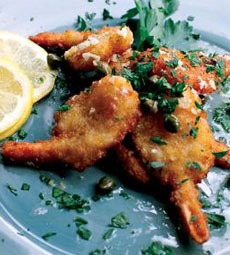It’s National Frozen Food Day. Who Invented Frozen Food?
|
While fresh is fashionable, we can’t ignore the importance of frozen foods today, National Frozen Food Day. While March 6th is one day to celebrate, the entire month of March is National Frozen Food Month. Frozen food revolutionized the way Americans consume food. First came the joy of off-season fruits and vegetables (which are tastier and a fraction of the price when purchased frozen at their peak than shipped fresh from South America or elsewhere). Then the ability to buy larger quantities when on sale. Then the convenience for busy moms. In 1984, President Ronald Regan declared March 6th to be National Frozen Food Day, stating: “…I call upon the American people to observe such day with appropriate ceremonies and activities.” Our ceremony consists of frozen foods for breakfast and dinner, at least. We already had a delicious Cedarlane omelet, and cooking SeaPak frozen butterfly shrimp for lunch (thanks, SeaPak, for the samples). (For dinner, it’s the last day of New York Restaurant Week and we’re heading out.) Most supermarkets today have 2-3 aisles of frozen foods, and many Americans rely upon the convenience of frozen food for their weekly dinners and other meals. |
 Today, it’s jumbo butterfly shrimp for lunch at THE NIBBLE. You can bake or fry the frozen shrimp. Photo courtesy SeaPak. |
|
 Butterfly shrimp “scallopini” with lemon, butter, garlic, parsley, and white wine. Here’s the recipe. Photo courtesy SeaPak. |
WHO INVENTED FROZEN FOOD: THE HISTORY OF FROZEN FOOD
Since ancient times, foods were frozen in climates that were cold enough to freeze them (here’s more about early freezing and refrigeration). But the invention of the home refrigerator-freezer after World War II brought modern-age frozen food into every home. Many people think that Clarence Birdseye invented frozen food; but in fact, others preceded him. However, Birdseye invented good-tasting frozen food. Before Birdseye, foods were frozen at a fairly slow rate. This caused large ice crystals to form, which ruptured the cell membranes of the food. When the food was defrosted, the ice crystals melted and water would leak from the food, taking with it flavor and texture. What Birdseye did invent, in 1924 was the quick freezing method, which produces the type of quality frozen foods that we know today. |
|
|
While working as a fur trader in Labrador, Newfoundland, Birdseye discovered that the fish that he caught froze almost immediately after being pulled from the water—and that the fish was just as delicious when thawed out months later. He developed quick-freezing methods that retained the taste and texture of foods. Another revolution in frozen food came in 1948 when Sea Island Packing Company (SeaPak) in Georgia developed the Individual Quick Freezing (IQF) to flash freeze shrimp. This process locks in flavor at its original state of freshness. The new process forever changed the way the shrimp industry (and others) would freeze products. [Source] The first home refrigerator with a small freezing compartment that held two ice cube trays was launched in 1923 (it was a Frigidaire—Source.) Large “deep freezers” for retail use only became common during the 1940s. That’s why people in period novels and films went to the neighborhood drugstore to get ice cream! Big freezers did not go into mass production for home use until after World War II. Along with new refrigerator-freezer units, they enabled American homes to stock ice cream and other frozen foods. Prior to World War II, Americans primarily ate locally and regionally grown foods. The technology didn’t exist to pack and transport fresh foods over greater distances. Consequently, only those who lived near coastal waterways had access to shrimp, clams, oysters, and other seafood. Since shrimp is America’s #1 consumed seafood—a lot of that, for both home and foodservice use, is frozen—and SeaPak Shrimp & Seafood Company is the #1-selling retail brand of frozen shrimp entrees, we make them our choice for lunch. Check out all the varieties at SeaPak.com. |
||


